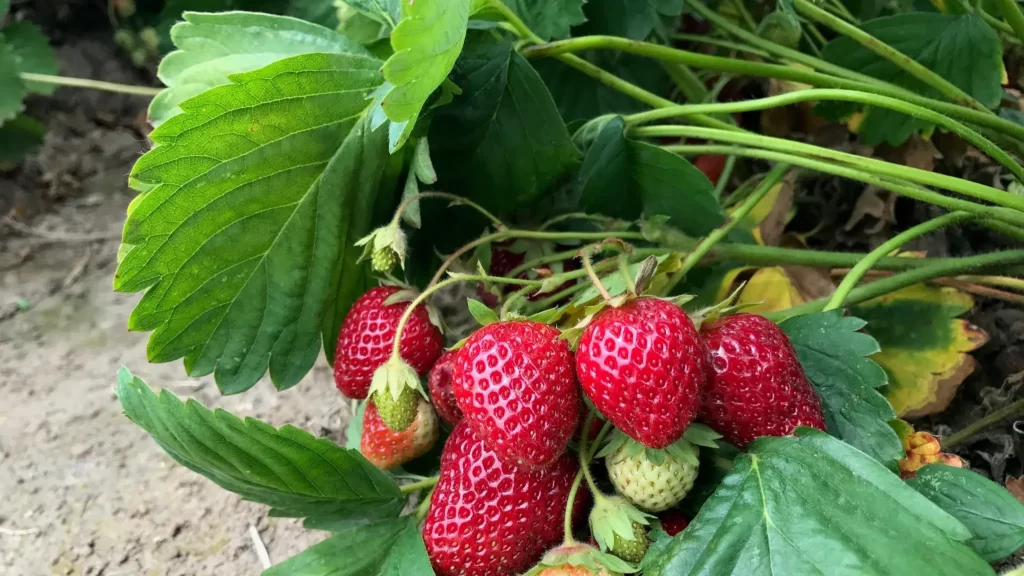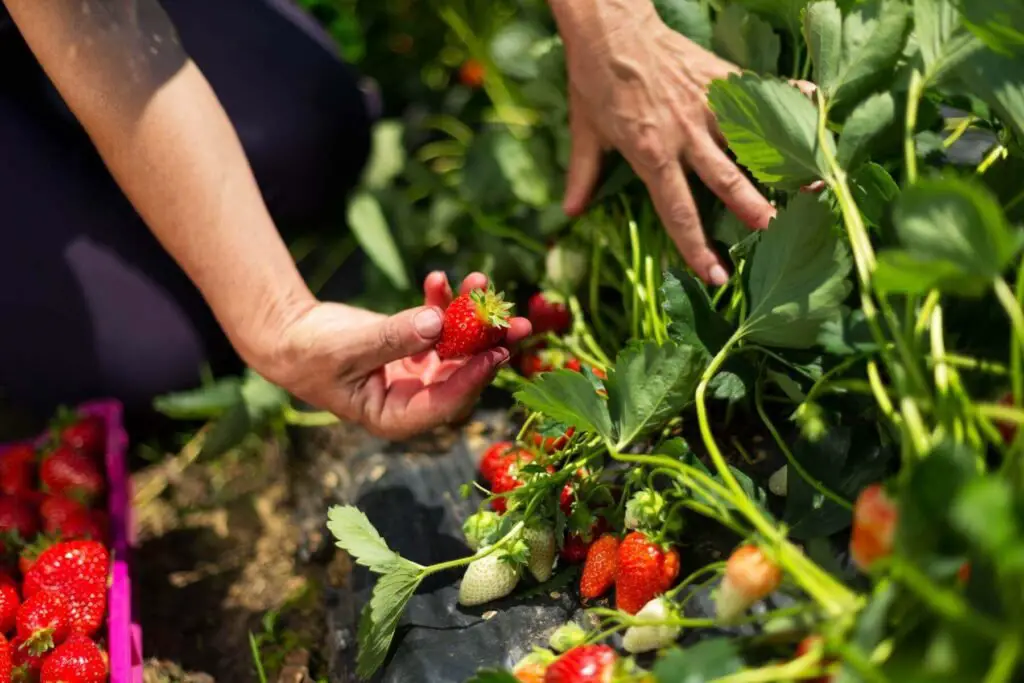Last Updated on August 15, 2023 By Emma W. Thomas
Plant strawberries in Florida from October to November for the best results. This timeframe capitalizes on the state’s mild fall climate, providing optimal conditions for strawberry plants to establish themselves before winter and produce a bountiful harvest in the following spring.
When to Plant Strawberries in Florida
- Early October to Late NovemberIn Florida, strawberries should typically be planted between early October to late November. This period is optimal because the strawberry plants can establish themselves before the winter period. This also allows them to produce a good crop in the spring.
- Advantage of Fall PlantingBy planting strawberries in the fall, gardeners can benefit from the warm Florida climate and the full sun position which strawberries love most. The resulting growth sets the stage for a bountiful strawberry harvest come springtime.
- Avoiding Frost DamageWhile Florida winters are relatively mild, occasional frost may occur. Strawberry plants are sensitive to frost, therefore gardeners are advised to provide frost protection for their plants. This can be as simple as covering crops with a frost blanket when the temperature dips below freezing.
- Plant Bare Root StrawberriesWhen you plant during this recommended timeline, opt for bare root strawberry plants. They adjust more easily to local soil conditions and tend to be healthier and more productive over time.
- Replacement and RotationSince strawberries are perennial plants, they will yield fruit for several years. However, their productivity declines after two to three years. To maintain a consistent strawberry yield, gardeners in Florida should replace their strawberry plants every 2-3 years.
- Watering and Fertilization RequirementsOnce strawberries are planted, they require consistent watering and proper fertilization to thrive. Gardeners should water young plants every day for a week, then reduce it down to 1-2 times per week depending on weather conditions.
- Timing HarvestIf planted in the fall, most strawberries in Florida start producing fruit in February and will continue until late April or May. During this time, gardeners can enjoy fresh, home-grown strawberries from their own gardens.
Table: When to Plant Strawberries in Florida
| Planting | Weather Precautions | Plant Type | Replacement & Rotation | Watering & Fertilization | Harvest |
|---|---|---|---|---|---|
| Early Oct – Late Nov | Frost Protection | Bare Root Strawberries | Every 2-3 years | Water daily first week then 1-2 times per week | Feb – Late April /May |
Remember, climate variations across different regions may influence the planting timeline. Keep track of local weather patterns and consult with local nurseries or agricultural extensions for additional tips on strawberry cultivation in Florida.
Step By Step Guide On How To Grow Strawberries

1. Choose An Ideal Strawberry Variety
How well your strawberry grows and produces fruit is dependent on its type and the environment that it is planted in. If you are in Northern Florida, the Omarosa variety will grow best there. For central Florida, the Festival is best for that area. Other varieties that you can grow in any part of Florida are Chandler, Selva, Oso Grande, and sweet sensation. There’s a breeding program by the University of Florida that comes up with new strawberry varieties meant for planting in Florida’s climate.
2. Select A Suitable Spot For Planting Your Strawberries
Whether you choose to plant strawberries directly on the ground or in containers, location is key. Strawberries need sufficient light for about 12 hours a day and warm temperatures between 50-80 degrees Fahrenheit. Choosing a spot with all these conditions will enable you to have quality and succulent strawberries. Ensure the spot you choose has fertile and well-drained soil. If you are planting strawberries directly on the ground, raise some rows of soil where your plant will grow. This system where the soil is raised is referred to as a hill system. Ensure your hill is about 8 inches high. These terraces help to keep fruits clean even when it rains because the soil won’t splash on them.
3. Plant Like A Professional
When you already know which variety you want and where to plant, it’s time to get to the actual planting. You can choose to start with seedlings from a local nursery and transplant them since it’s easier and less involved. If you want some thrill and risk-taking, then growing strawberries from seeds is for you. Germinating strawberry seeds until they grow into seedlings that are ready for transplanting is a delicate, involving but fun process.
When your seedlings are ready for planting, ensure you water the soil for sufficient moisture. Experts advise planting your seedlings in the evening or when the weather is chilly for them to transition effectively from indoors to the outside. When planting, dig a hole and put in your seedling, ensuring the crown is at ground level. Inspect to confirm the hole is not too shallow to cause drying of the roots, which kills a strawberry plant.
4. Caring For Your Strawberry Plant And Providing Necessary Nutrients
Once your plant is planted and well established, it’s time for pampering as you wait for flowering and fruits. Strawberry plants don’t need special care routines, but they thrive on some love.
Mulching is a process you shouldn’t ignore if you are looking forward to a bountiful and clean harvest. You can use either compost or straw to mulch your strawberries. Mulching helps to keep the soil cool while inhibiting weeds and at the same time keeping the fruits clean.
It would help if you also watered strawberries regularly for them to thrive. When a strawberry plant is blooming and forming fruits, it needs about two inches of water. When watering your plant, put your finger in the soil to feel the depth of moisture. Strawberries need well-draining soil to keep their roots from rotting due to too much water.
Another essential part of caring for strawberries is by applying fertilizer. You can opt for organic fertilizer such as bone meal or a balanced fertilizer to boost nitrogen levels in the soil. A well-fertilized strawberry plant will produce healthy fruits that are not soggy. When using organic fertilizer, applying once a month is recommended. For other fertilizers, you can apply just before planting and add only when your plant demands. You need to be careful when applying fertilizer to growing strawberries since too much fertilizer leads to overgrowing of leaves, which inhibits fruit production.
Pest and disease control is a crucial part of caring for your strawberries. In Florida, the main pest concern is birds, which eat your fruits as soon as they appear. To control them, you can use a simple net to keep them outside your garden area. Strawberries are also prone to insect infestations by caterpillars, aphids, and spider mites. These insects can be eradicated using organic and environmentally friendly insecticides. Diseases such as nematodes, verticillium, and mildew are also common in some parts of the state. You can control diseases by ensuring you plant healthy seedlings from a reputable nursery and using recommended fungicides. For pests and diseases, it is advisable to consult a specialist early enough to help eradicate them.
5. Harvesting
After all the hard work, it’s time to reap your strawberries. This is by far the most exciting part of planting strawberries. In Florida, harvesting is done between February and March when berries start ripening. When harvesting, only pick strawberries that are red since they won’t sweeten after they are plucked. If more than three-quarters of the fruit is ripe, then the strawberry is ready for harvest. Strawberries do not stay long after harvesting, and you should therefore freeze or preserve any surplus to prevent spoiling. During harvest, it is advisable to keep a close eye on ripe berries and harvest them before they go bad. Harvesting after every three days is the best practice to ensure all fruits are picked before they go bad.
In case you have an overflowing harvest, you might need to preserve some strawberries and store them for use in the future. We researched and compiled a few tips to help you preserve and store strawberries. Read on and choose one that works best for you.
Tips On How To Preserve And Store Strawberries
1. Strawberries require proper storage to prevent mold and keep them from withering. For short-term storage, you can put strawberries in a tin and place them in the coldest part of your fridge
2. If you plan to store your strawberries for months, then freezing is a better option. Frozen berries can last up to five months and can be thawed for baking or making juices and smoothies. Ensure you store berries in a freezer bag to prevent freezer burns
3. You can choose to dry or dehydrate strawberries and use them on your cereal. You can either dry them in an oven or use a dehydrator for the best results. After drying for about 12 hours, store them in an airtight container, and they can last for up to a year or two if you put them in a freezer
4. If you are open to trying out new things with strawberries, you can make a homemade strawberry jam or preserve it. You can search for recipes online and try out one that excites you. Some people also make strawberry wine, which takes up to a year to ferment, but the results are worth waiting for.
Whichever method of preservation you choose will help you enjoy your strawberries to the fullest without worrying about them going bad.
Fun Facts About Strawberries

Here are some interesting facts that you might not have heard before concerning USA’s most popular fruit:
- Strawberries contain 90% water and 8% carbohydrates with very little proteins and fats
- They have numerous health benefits, including improved brain function and relief from high blood pressure
- There’s a strawberry museum in Belgium that is solely dedicated to strawberries and their by-products
- An average strawberry has about 200 seeds
- Strawberry plants are members of the rose family
- Strawberries are different from most fruits since they do not continue to ripen after plucking
- In every 100 grams of strawberries, there are 30 calories
Conclusion
Whether you are a first-time strawberry farmer or you’re planning to do it again, but with more knowledge, this information will come in handy. Planting and nurturing strawberries in Florida and other parts of the world is exciting, especially with the right knowledge.
It would be best if you consulted a professional before you start to have your soil nutrient level checked. If you just want a few berries for yourself and your family, the information in this guide is probably all you need to have a bountiful harvest.
That’s all you need to know about planting strawberries in Florida; we wish you all the best as you embark on this exciting journey.
References:
https://www.floridayards.org/growing-strawberries-in-florida/
https://www.flgardening.com/how-to-grow-strawberries-in-florida/
Emma is a graduate of Domestic Science or Family and Consumer Sciences (Home Economics) from the University of Wisconsin. She has 7 years of experience Working with the strategic section of BestBuy and now writing full-time for Homeeon.
From Managing the Home, Interiors, Cleaning, and Exteriors to Gardening and everything about Making A Home Liveable – is her passion and this Homeeon is the result of this.
Emma loves decorating her home with the best stuff found online. She cares about quality over anything and writes reviews about them here in Homeeon. Get in touch with her over Pinterest.
Keep reading her blogs.

